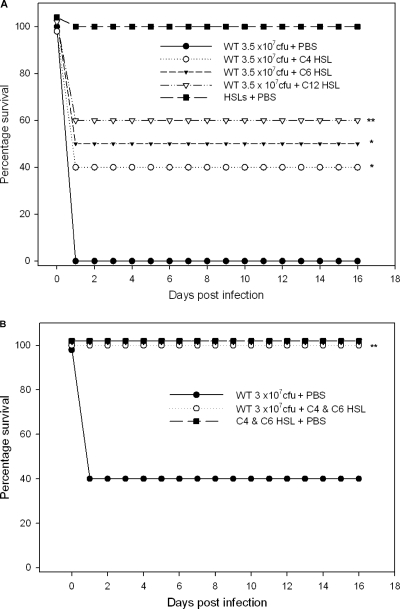Fig. 1.
Survival of Swiss-Webster mice that were pretreated with AHLs by the i.p. route prior to A. hydrophila challenge. Percentages of surviving mice over time are shown, and the data were analyzed by using the Kaplan-Meier survival estimates. (A) Mice (n = 10, each group) were treated with 250 μM per 100-μl dose each of C4-HSL, C6-HSL, 3-oxo-C12-HSL, or PBS (control) at 12 h and 6 h before A. hydrophila challenge by the i.p. route with 3.5 × 107 CFU. Mice (n = 5, each group) were also treated with 250 μM (each) C4-HSL, C6-HSL, and 3-oxo-C12-HSL without bacterial infection and served as controls for determining toxicity of HSL molecules. The survival percentages were statistically significant between control and C4-HSL-treated (*, P = 0.03), C6-HSL-treated (*, P = 0.01), and 3-oxo-C12-HSL-treated (**, P = 0.004) mice after A. hydrophila infection. (B) Mice were treated with combined doses of C4-HSL and C6-HSL (250 μM each) or PBS (n = 10, each group) 12 h and 6 h before A. hydrophila challenge with 3 × 107 CFU. Mice were observed for deaths for 16 days postinfection. Mice (n = 5) were also treated with combined doses of C4-HSL and C6-HSL (250 μM each) without bacterial infection as a toxicity control. **, statistically significant difference in the survival rate of mice between control and combined treatment with C4-HSL and C6-HSL (P = 0.004) after bacterial infection.

